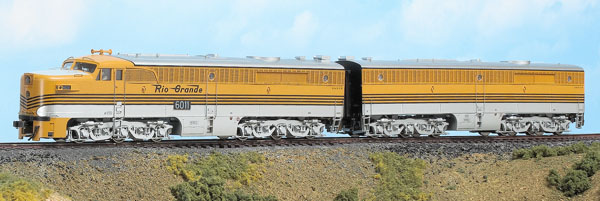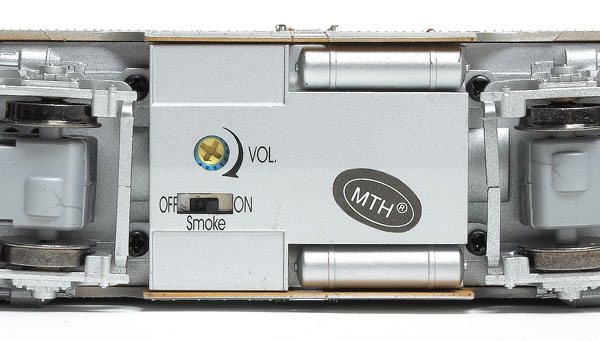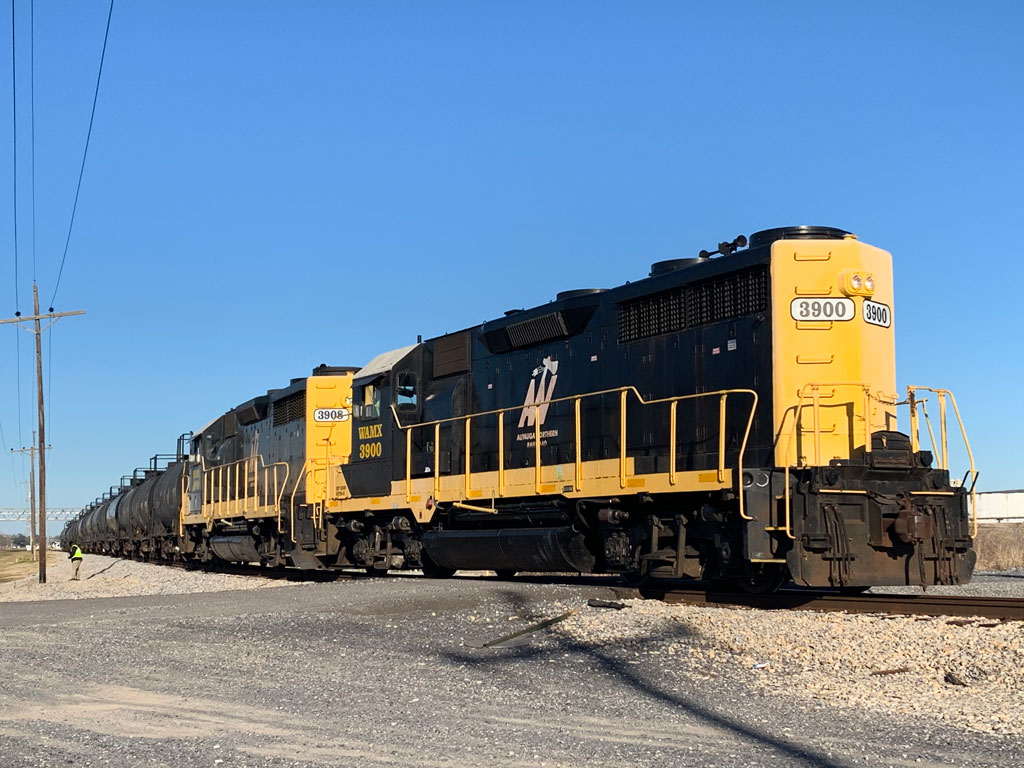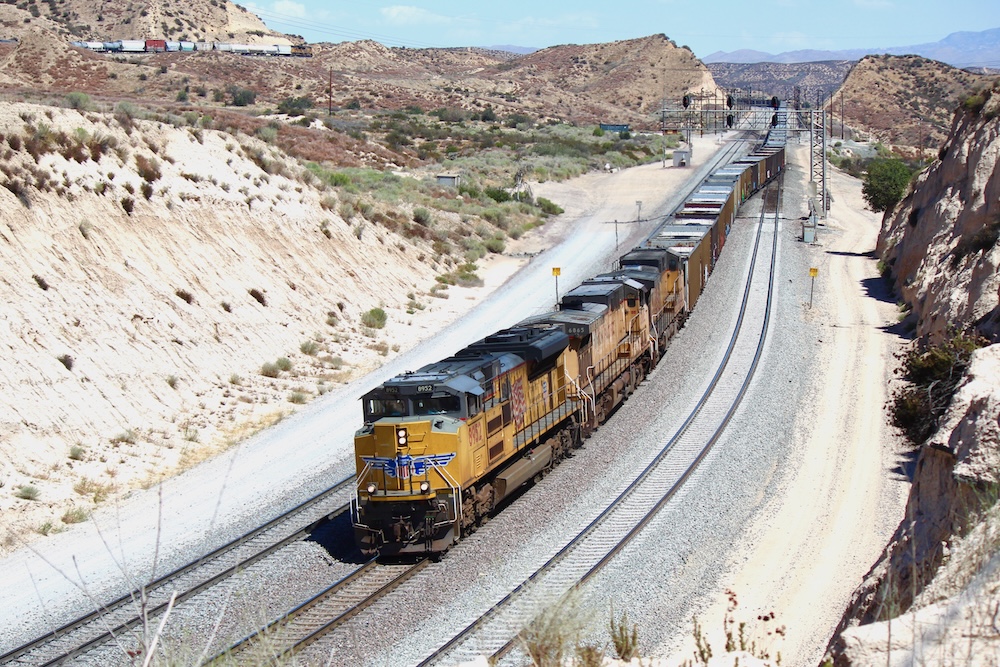The prototype. Alco introduced the 2,000 hp PA-1 and cabless PB-1 diesel-electric passenger locomotives in 1946. In 1950 Alco began producing visually identical 2,250 hp versions that were
later designated PA-2 and PB-2. All PAs rode on six-wheel A-1-A trucks, which had an idler axle between two powered axles. In all Alco built 297 PAs for 16 railroads across the United States.
The Denver & Rio Grande Western received four PA-1s and two PB-1s between January and April 1947. Although the A-B-A sets were intended as power for the 1949 California Zephyr, the Alcos proved unable to make the train’s schedule over the Rockies and were replaced by A-B-B-A sets of Electro-Motive Division F units. The Rio Grande assigned the Alcos, usually as single units or pairs (A-A or A-B), to other trains through the 1960s. The PB-1 units were rebuilt as steam generator cars.
The plastic body shell has sharp molded detail. Separately applied detail parts include handrails, see-through radiator fan and air intake grills, and windshield wipers. The brake cylinders on the plastic truck sideframes are separate parts.
Our review sample is detailed and decorated as the prototype no. 6011 looked after 1952. The model includes the nose ladder that the railroad added to the PAs starting in the 1950s. By the 1960s the Rio Grande PAs also had a handrail and toe creepway along the side of the nose in front of the cab door. This detail isn’t on the MTH model.
Rio Grande ordered its PAs with m.u. receptacles. One receptacle should be on each side of the headlight but are missing from the model. Detail Associates makes these parts (no. 1507) for modelers who wish to add them. The Rio Grande PAs also had a gyrating warning light mounted above the headlight, and this feature is included.
The post-1952 paint scheme on the model features sharp color separation. The stripes are straight and the lettering is placed correctly, according to prototype photos. The tiny maintenance stencils are legible under magnification. An equipment trust plate and Alco builder’s trust plate are also printed in their prototypical locations on the model.
I tested the PA with a Model Rectifier Corp. (MRC) Tech 4 DC power pack and an NCE Corp. Power Cab DCC system. The locomotive ran well during those speed tests, as you can see from the charts at the right. Like other sound-equipped models, the MTH PA took a lot of voltage to get moving in DC – 7.25 volts. The model can handle up to 24V DC.
In DCC, the model crept smoothly at 1 scale mph in speed step 1 after I set the DCS receiver to 128 speed steps. Using configuration variables (CVs), modelers can also choose from 17 preset speed
tables or program a custom table to fine-tune the model’s performance.
I also ran the model using a DCS Commander. The PA accelerated from 1 scale mph to a top speed of 87 mph. A prototype PA-1 could be geared for top speeds between 80 and 117 mph.
The fan-driven smoke unit provides a steady stream of white smoke, although it took a few minutes for the heating element to warm up. You can also shut this feature off via a switch on the bottom of the model’s fuel tank. With DCS and DCC systems, you can adjust the output of the smoke.
The ProtoSound 3.0 system’s rendition of a 16-cylinder Alco 244 diesel engine sounds like prototype recordings and videos. There were no buzzes or rattles even when I turned the master volume knob (mounted on the underside of the fuel tank) to its highest level. The volume can also be adjusted with a DCC or DCS throttle.
Sound effects on a DC layout include random air releases and crew dialogue and a couple controllable effects. The rpms increased as I advanced the throttle. A quick decrease of the throttle caused a squealing brake sound.
Running the model with a DCC or MTH DCS system provides more control over the model’s sound effects and programming options. User-controlled functions include the whistle, bell, and a train arrival and departure sequence.
The front and rear couplers also open with the touch of a button on a DCC or DCS throttle. Because of the spring tension required for the couplers to open remotely, the model must be moving at least 22 scale mph for the couplers to engage the coupler of an adjacent car and close their knuckles. This speed would be considered too fast at a prototype coach yard. However, remote uncoupling would be great for dropping trains in passenger terminals.
There are 28 functions in all. These functions can also be mapped to different keys on a DCC throttle. This is especially useful for those modelers who don’t have 28-function DCC throttles.
The models can be programmed on the main or via a programming track. Programmable CVs include the locomotive address, acceleration/deceleration rates, minimum/maximum voltages, and advance consisting. I changed the long addresses of both locomotives. I also easily advance consisted our PA and PB units using CVs 19, 21, and 22 as outlined in the instructions.
The operating smoke is a fun feature, but I’m more excited that MTH has expanded the DCC capability of its locomotives since its first HO releases. This Alco PA would look and sound great at the head-end of a California Zephyr or Royal Gorge consist.
Manufacturer
MTH Electric Trains
7020 Columbia Gateway Dr.
Columbia, MD 21046
mthhotrains.com
Road names: Denver & Rio Grande Western; Atchison, Topeka & Santa Fe; Delaware & Hudson; Erie; New York Central; New York, New Haven & Hartford; Southern Pacific.
Era: 1946 through 1960s
Features
- All-wheel drive and electrical pickup
- Die-cast metal chassis
- Digital Command System with ProtoSound 3.0 operates on DC, DCC, and DCS layouts (DCS version only)
- Eight-pin DCC socket (DC version)
- Five-pole skew-wound flywheel-equipped motor
- Minimum radius: 22″
- Operating smoke unit
- (DCS version only)
- Painted engineer and fireman figures in A unit
- Remote-opening knuckle couplers at correct height (DCS version only)
- RP-25 contour metal wheels
- in gauge
- User-installed Kadee compatible knuckle couplers
- Weight: 1 pound 51⁄2 ounces (A unit), 1 pound 7 ounces (B unit)

















